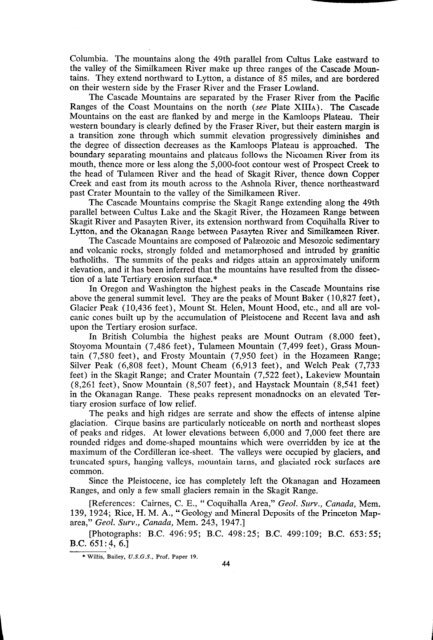Landforms of British Columbia 1976 - Department of Geography
Landforms of British Columbia 1976 - Department of Geography
Landforms of British Columbia 1976 - Department of Geography
You also want an ePaper? Increase the reach of your titles
YUMPU automatically turns print PDFs into web optimized ePapers that Google loves.
<strong>Columbia</strong>. The mountains along the 49th parallel from Cultus Lake eastward to<br />
the valley <strong>of</strong> the Similkameen River make up three ranges <strong>of</strong> the Cascade Moun-<br />
tains. They extend northward to Lytton, a distance <strong>of</strong> 85 miles, and arc bordered<br />
on their western side by the Fraser River and the Fraser Lowland.<br />
The Cascade Mountains are separated by the Fraser River from the Pacific<br />
Ranges <strong>of</strong> the Coast Mountains on the north (see Plate XIIIA). The Cascade<br />
Mountains on the east are flanked by and merge in the Kamloops Plateau. Their<br />
western boundary is clearly defined by the Fraser River, but their eastern margin is<br />
a transition zone through which summit elevation progressively diminishes and<br />
the degree <strong>of</strong> dissection decreases as the Kamloops Plateau is approached, The<br />
boundary separating mountains and plateaus follows the Nicoamen River from its<br />
mouth, thence more or less along the 5,000-foot contour west <strong>of</strong> Prospect Creek to<br />
the head <strong>of</strong> Tulameen River and the head <strong>of</strong> Skagit River, thence down Copper<br />
Creek and east from its mouth across to the Ashnola River, thence northeastward<br />
past Crater Mountain to the valley <strong>of</strong> the Similkameen River.<br />
The Cascade Mountains comprise the Skagit Range extending along the 49th<br />
parallel between Cultus Lake and the Skagit River, the Hozameen Range between<br />
Skagit River and Pasayten River, its extension northward from Coquihalla River to<br />
Lytton, and the Okanagan Range between Pasayten River and Similkameen River.<br />
The Cascade Mountains are composed <strong>of</strong> Paleozoic and Mesozoic sedimentary<br />
and volcanic rocks, strongly folded and metamorphosed and intruded by granitic<br />
batholiths. The summits <strong>of</strong> the peaks and ridges attain an approximately uniform<br />
elevation, and it has been inferred that the mountains have resulted from the dissec-<br />
tion <strong>of</strong> a late Tertiary erosion surface.*<br />
In Oregon and Washington the highest peaks in the Cascade Mountains rise<br />
above the general summit level. They are the peaks <strong>of</strong> Mount Baker (10,827 feet),<br />
Glacier Peak (10,436 feet), Mount St. Helen, Mount Hood, etc., and all are vol-<br />
canic cones built up by the accumulation <strong>of</strong> Pleistocene and Recent lava and ash<br />
upon the Tertiary erosion surface.<br />
In <strong>British</strong> <strong>Columbia</strong> the highest peaks are Mount Outram (8,000 feet),<br />
Stoyoma Mountain (7,486 feet), Tulameen Mountain (7,499 feet), Grass Moun-<br />
tain (7,580 feet), and Frosty Mountain (7,950 feet) in the Hozameen Range;<br />
Silver Peak (6,808 feet), Mount Cheam (6,913 feet), and Welch Peak (7,733<br />
feet) in the Skagit Range; and Crater Mountain (7,522 feet), Lakeview Mountain<br />
(8,261 feet), Snow Mountain (8,507 feet), and Haystack Mountain (8,541 feet)<br />
in the Okanagan Range. These peaks represent monadnocks on an elevated Ter-<br />
tiary erosion surface <strong>of</strong> low relief.<br />
The peaks and high ridges are serrate and show the effects <strong>of</strong> intense alpine<br />
glaciation. Cirque basins are particularly noticeable on north and northeast slopes<br />
<strong>of</strong> peaks and ridges. At lower elevations between 6,000 and 7,000 feet there are<br />
rounded ridges and dome-shaped mountains which were overridden by ice at the<br />
maximum <strong>of</strong> the Cordilleran ice-sheet. The valleys were occupied by glaciers, and<br />
truncated spurs, hanging valleys, mountain tarns, and glaciated rock surfaces are<br />
common.<br />
Since the Pleistocene, ice has completely left the Okanagan and Hozameen<br />
Ranges, and only a few small glaciers remain in the Skagit Range.<br />
[References: Cairnes, C. E., “ Coquihalla Area,” Geol. &U-V,, Cunuda, Mem.<br />
139, 1924; Rice, H. M. A., “Geology and Mineral Deposits <strong>of</strong> the Princeton Map-<br />
area,” Geol. Surv., Canada, Mem. 243, 1947.1<br />
[Photographs: B.C. 496:95; B.C. 498:25; B.C. 499:109; B.C. 653: 55;<br />
B.C. 651: 4, 6.1<br />
*Willis, Bailey, U.S.G.S., Pr<strong>of</strong>. Paper 19.<br />
44











